#Fate Accessibility Toolkit
Explore tagged Tumblr posts
Text
Weekend Update: 9/21/2024
Welcome to the Cannibal Halfling Weekend Update! Start your weekend with a chunk of RPG news from the past week. We have the week’s top sellers, industry news stories, something from the archives, and discussions from elsewhere online. Continue reading Weekend Update: 9/21/2024
1 note
·
View note
Text
It's Disability Pride Month! I've already made a post spotlighting disabled creators. Now, let's have a post of accessibility aids for use within your gaming worlds!
Blades in the Dark: Mobility Equipment by Aurelia
Cost: PWYW
A collection of mobility items for Blades in the Dark, from a disabled creator. Two items for every playbook- well worth checking out!
Combat Wheelchair (5E) by Mark Thompson
Cost: free! Link is to google drive.
Here it is- the by now famous Combat Wheelchair! One of the best known mobility aids created for 5th edition Dungeons and Dragons.
Fate Accessibility Toolkit by Evil Hat
Cost: $7.50
This toolkit provides tools for representing disabilities within Fate games, as well as advice for supporting players with disabilities at your table. It was put together by a team of disabled creatives, so you know this was made with love and from real people's experiences.
Homebrew Disability Systems for 5E by harpoon_gun
Cost: PWYW
Highly rated set of mechanics for 5th edition Dungeons and Dragons, brought to you by a disabled creator. Useful for both NPCs and player characters.
Service Monsters (5E) by PsychHound
Cost: PWYW
Service monsters to aid your disabled characters in 5th edition Dungeons and Dragons! There are multiple options to choose from (including guide, medical alert and autism support monsters), each with unique traits supporting their role. There are also a bunch of backstory ideas, to inspire the story of how your service monster came to be in your service!
(PsychHound has also created trauma mechanics and mechanics for autism and ADHD! The latter is informed by his own experiences as an autistic social worker.)
We Are Still Here by Ennis Rook Bashe
Cost: PWYW
Mobility aids and medications suitable for use in Apocalypse World and many other Powered by the Apocalypse games. Very highly rated by the Itch community!
#disability pride month#accessible ttrpg#blades in the dark#dungeons and dragons#powered by the apocalypse#fate rpg
70 notes
·
View notes
Text
The Sunspot Chronicles: Trial Run (ttrpg)
We have just had our own table top role playing game published!
It's set up to run like the very first test game we played using GURPS back in September of 2000 (not the GURPS part - ugh - but the setting).
You play a youngster on the Sunspot, or an Exodus Ship of your own naming, who is being given a trial run of some new technology that will link you up to the ship's Network in a way you haven't had access to before. It gives you something akin to superpowers. And the resulting story might involve discovering the origins and purpose of the ship, which have been forgotten with time.
Also, you are an alien furry. A chimerical mix of animalistic traits unique to you and no one else on the ship.
Each player gets to invent an answer to one of a set of important questions, while the other players don't yet know that answer, and the GM decides which of the players' answers are true or not.
So, at the beginning of the game, the PCs have an opportunity to trade notes, and then decide which ones they want to try to pursue, or what they want to do about them.
And the world building can escalate from there as you play!
Part of the whole idea of this setting as a game was to make it possible to mix all kinds of genres, from anime and Saturday morning cartoons to horror, from science fiction and cyberpunk to cozy furry slice of life drama. Anything that inspires you.
This setup allows you to either play by using our novels as a source material, or for you to create your own setting entirely, if you want.
You can find it here:
You'll want to be sure to download the character sheet as well as the copy of Xine Two. It is built using Cortex Prime, so you'll need familiarity or access to the toolkit book to play (we had a hard limit on words, so we had to reference rules instead of spelling them out), which you can find here:
But, this is just the first step we're taking to create a fully fleshed out game you can just download and play (or reference off the website).
Cortex is a lot of fun. It's very similar to the Fate system, which would have been our goto if we hadn't been sucked into Cortex first.
It's a narrative driven system, so the dice aren't being used to badly simulate physics to any sort of minute detail. The dice ranking is used to give your character's traits more or less weight in influencing the direction of the story. And in Cortex there is a plot point system that directs the development of twists and setbacks that can later culminate in a heroic finish. And it's streamlined enough that we (at least) can focus on the story and role playing more than the game engine, but just crunchy enough to give some sense of strategy and tactics.
We're planning on hosting some games of this on the Cortex Prime discord server, and maybe on our own as well, depending on energy and time. We'll post about that with ample warning when we do it.
10 notes
·
View notes
Text
Trump has the economic tools to end Russia’s war. He should use them

There are still many questions about what to expect from the Trump administration’s approach to ending Russia’s war in Ukraine. With some in Congress questioning continued military aid and loans for Ukraine, the application of economic statecraft measures —such as sanctions, export controls, and tariffs — could be used more aggressively to push for Russia’s withdrawal.
Sanctions were a key tool in the first Trump administration’s foreign policy strategy. However, we’ve heard little about how a second-term Trump administration plans to leverage them. Recently, U.S. President Donald Trump warned Russian President Vladimir Putin that new tariffs and sanctions would be imposed on Moscow if it didn’t reach a deal to stop the war. With so many rounds of sanctions already imposed by the United States and its broad multilateral coalition, what options remain?
Two key levers could help achieve the ultimate goal of this pressure campaign: further disrupting Russia’s energy trade and tightening restrictions on dual-use goods flowing to Russia through third countries that support its military.
“Two key levers could help achieve the ultimate goal of this pressure campaign.”
First, a more aggressive use of secondary sanctions could prove effective. Secondary sanctions, which force countries to choose between doing business with the U.S. or with sanctioned entities, were instrumental in bringing Iran to the negotiating table for the Joint Comprehensive Plan of Action (JCPOA). Secondary sanctions on Russia, imposed by then-U.S. President Joe Biden in December 2023, have begun to take effect. It is conceivable that a second Trump administration could use this tool to pressure unaligned countries — including some current U.S. allies — to align with American objectives.

Russian President Vladimir Putin (L) holds a vicdeo call with Chinese President Xi Jinping (R) at his residence outside Moscow, Russia, on Jan. 21, 2025. (Gavriil Grigorov / Pool / AFP via Getty Images)
More aggressive threats of cutting off access to the U.S. economy for entities in countries such as India, China, Turkey, and Middle Eastern nations — where businesses continue trading with Russia while maintaining ties with the U.S. and its allies — could be considered. Even amid debates over continued aid to Ukraine, increasing pressure on these nations to stop their companies from purchasing Russian energy products or facilitating the flow of dual-use items to Russia could be an effective strategy with limited cost to American taxpayers.
Second, lessons from previous sanctions campaigns show that aggressive enforcement serves as an additional stick to influence corporate decision-making. At one point, fines for sanctions violations reached upward of $9 billion. While enforcement should not be politicized, prioritizing cases against well-known violators of Russia sanctions could have a strong deterrent effect on those skirting the rules.
Some have suggested easing certain sanctions to incentivize Russia to negotiate. However, this approach would likely be ineffective in changing the trajectory of the war, as Putin responds only to force. Trump has made no secret of his willingness to use the U.S. economic statecraft toolkit to achieve policy objectives. Ending the war is a bipartisan priority, but more importantly, Russia must not be allowed to win — otherwise, other countries could face a similar fate.
When it comes to Russia, Trump should leverage the considerable economic power at his disposal to remind those doing business with both Russia and the U.S. that access to American markets is a privilege, not a right. Given the choice between access to the U.S. economy and trade with Russia, many countries would quickly opt for the former. A firm stance on economic pressure could accelerate an end to the conflict and reinforce American leadership on the world stage.
Editor’s Note: The opinions expressed in the op-ed section are those of the authors and do not necessarily reflect the views of the Kyiv Independent.
Submit an Opinion
Kyiv and Washington’s mobilization age blame game misses the point
“The biggest problem is the lack of people.” These words, heard by journalists, including myself, from Ukrainian soldiers and commanders across the front line for the past year, are no outlier. For most of 2024 and into 2025, Ukraine’s biggest issue on the battlefield has not been firepower but

The Kyiv IndependentFrancis Farrell

0 notes
Text
[ad_1] The collapse of FTX has cast a long shadow over Web3. Critics argue the company’s failure is proof that this new technology is a net negative to society when left to the free market, giving speculators new ways to gamble and criminals’ new tools to evade law enforcement.Indeed, as the trial of FTX founder Sam Bankman Fried (SBF) is set to begin, the New York Times tells us crypto is on trial, and that the case will surely shine a “harsh glare” on all in the industry, like a blacklight on the proverbial hotel bedspread. Tying the fate of the industry to a spectacular failure fits a familiar pattern. The South Sea Bubble was blamed on the corporation itself. In 2009, the New York Times wrote that capitalism was on trial for the Financial Crisis. Sound familiar?Alex Tapscott is the author of the new book "Web3: Charting the Internet’s Next Economic and Cultural Frontier" out now.In actuality, we can blame the collapse of FTX not on Web3 or specific innovations like tokens but on the hubris and misdeeds of those wielding them. More simply put, FTX was likely garden-variety fraud.I have spent the last two years writing a new book, “Web3: Charting the Internet’s Next Economic and Cultural Frontier,” shining a light on the ways in which citizens, entrepreneurs, creators and business leaders are being impacted by Web3. I have reached a different conclusion: If Web1 and Web2 democratized access to information and made it easier to meet and collaborate online, Web3 equips us with a more powerful toolset to earn money, own assets, and build wealth on a globally level playing field, decentralizing power and influence in the process.While the FTX case reinforces the stereotype that crypto is the domain of rich tech bros and other entitled elites, the bigger picture is more nuanced. Other than the U.S. and Ukraine, the top ten counties for crypto adoption, according to Chainalysis, are all in the Global South, in countries like Vietnam and the Philippines.Meet SeviFar away from the Manhattan courthouse where SBF is being tried, we see a different narrative unfolding, featuring Sevi, a 10-year-old autistic artist living in the Philippines. Like many families, Sevi’s carried the financial burden of providing specialized care for their autistic child. Early programs in art therapy, gymnastics and football helped Sevi develop essential skills and navigate social interactions. But the costs mounted. Ultimately, Sevi’s family asked him which program he wished to continue. He chose art.When words failed him, Sevi’s mother, April Agregado, discovered he could communicate more easily through his paintings. She began sharing his artwork on social media, where it gained the attention of friends and family. Some even expressed interest in purchasing his pieces. Initially hesitant to sell her son’s art, April learned about the market for NFTs. With the guidance of her friend, April began minting NFTs, essentially creating unique digital versions of Sevi’s art.NFTs are now often seen as speculative playthings promoted by unscrupulous promoters, celebrities, and other peddlers. Regrettably, as with everything in this nascent industry, that has a ring of truth to it. But NFTs are also one of several tools in the Web3 toolkit that can help creators flourish wherever they are in the world. Yat Siu, a prominent industry investor, told me recently “If bitcoin is a store of value, NFTs are a store of culture.”Read more: Emily Parker - Michael Lewis Was Charmed by Sam Bankman-Fried – But So Was Everyone ElseIn Sevi’s case, they function as exclusive and authorized digital twins of Sevi’s copyrighted work, where Sevi retains the original, but NFT buyers hold second sale rights, that is, the right to sell their NFTs to somebody else. April listed a selection of Sevi’s art pieces on the NFT marketplace OpenSea, accompanied by information about Sevi himself.Sevi’s story resonated profoundly within the burgeoning Web3 community at home and abroad. His NFTs began to sell, and he garnered an invitation to showcase his work at NFT.
NYC, one of the industry’s largest events. There, his creations graced a Times Square billboard.To date, Sevi has earned around $16,000 from sales of his digital art — that’s more than the average annual income of a Filipino. While Sevi’s journey as an artist may be unique, the Web3 tools his family used are accessible to everyone. These tools give individuals a means of tracking provenance of their digital assets, from creation to the latest transaction, a paradigm shift with far-reaching implications.Sevi’s newfound financial independence also grants him the freedom to pursue diverse interests. His mother April hopes he will rekindle his passion for football or gymnastics. The NFTs that have empowered Sevi’s family are the same tools for rebalancing the power among creators, consumers, and the intermediaries between them.Back in the United States, Silicon Valley has been described as a “Tech Galapagos,” a place where unique conditions breed Internet giants. But Web3 transcends geographical boundaries, with potential to level the playing field and democratize economic opportunities for creators worldwide.Sevi serves as a powerful testament to the transformative potential of Web3. His family demonstrates that Web3 is not just a buzzword or an abstract concept; it’s a game-changer with real-world impact on people’s lives. While Sevi’s story as an artist may not be replicable, the tools he used are available to everyone. They give individuals ownership over their digital goods — in this case, a talented autistic boy’s art. For now, Sevi is happy doing art, but his interests might change. Sevi’s mom, April, would love Sevi to pick up football or gymnastics again. Thanks to his art and Web3, they can now afford to give him the help he needs. [ad_2] Source #SBF #Trial #Web3 #Narrative #Unfolding
0 notes
Note
Two excellent published resources are the Fate Accessibility Toolkit and, oddly enough, the Planet Mercenary Role-Playing Game, which has a very thorough chapter on the subject.
Do you happen to have any resources regarding accessibility in ttrpg design? About design, colours, phrasing of text or anything else that could be helpful!
I spent wayyyyy too long compiling all this - but it's important, and I appreciate you asking!!
Accessibility is a subject near and dear to my heart, and I will say up front that I'm not sure universal (aka accessible to everyone) design is possible, because people's needs can vary even within the same subset of similar disabilities (such as limited vision or blindness). BUT that doesn't mean we don't try to design for and make our games available to as many people as possible. Mismatch by Kat Holmes is a great read on design for accessibility in general, as is Invisible Women by Caroline Criado Perez. You might also check out literally anything Alice Wong has ever done.
To start, I recommend this article on the Lenses of Accessibility.
(for reference, this article is about web/graphic design, so I'm going to try and distill the most salient points for game design)
We are going to primarily focus on a few of these lenses:
Color
Font
Images & Icons
Layout
Readability
Structure
Keyboard
More details under the cut.
Color
Why does color matter? Well, for starters, there's a lot of colorblind people out there. Contrast affects readability. Autistic people and people who suffer from occular migraines might be affected by particular vivid colors. There's lots of reasons to consider color and the work it is doing in your piece, but in general you can provide a black and white, high contrast version of your game to help users.
There are tools out there to figure out if your contrast meets certain readability standards, such as this one.
Font
Dyslexia and other visual processing issues can make font choice really important. Plus, some fonts really affect readability. Additionally, line height, justification, and size of text can affect readability.
Best practice would be to provide a plain-text version of your game (and beware of "dyslexia-friendly" fonts which may or may not actually help - sticking to a basic readability font like Arial, Tahoma, or Verdana, is safest). I like this style guide for reference.
Images & Icons
For visually-impaired people, it's important to use alt-text, descriptions, and/or captions to help screenreaders properly translate images. Tons and tons of details that could go into this, but there are better people than me to describe it.
Layout
We've talked about this a bit, but there's tons of resources for this. There was recently a great writeup about Yazeba's Bed and Breakfast in terms of layout that I highly recommend.
Readability
More of the thing we've already talked about - it really is a combination of all the other lenses that comes down to readability. Audio versions of your game are always a good way to avoid the restrictions of screen readers, but can be expensive to produce.
Structure
This is tables. Tables are a nightmare for screenreaders, but including them as images can also be a problem. The short solution is "don't use tables" but that's not necessarily great for seeing people. The section in this blog is really great when talking about options for structure.
Keyboard
Debated on whether to include this, but given how many games are being read as purely digital files, I think it's important to have workable interactive elements that can be navigated through without a mouse. Some of that is going to come down to the programs being used to open your files. But if there are things you can do on your end (such as labeling form fillable fields on an interactive character sheet), they're worth doing!
Please understand that this isn't an exhaustive list. There's tons of resources out there and technology and standards are constantly changing.
It's also is important to note that even doing one of these things is helpful. You might look at this list and go "wow that's too hard" but I promise you, it's worth it. My games do not all have accessible versions! That's something I'm trying to rectify. The biggest part of that for me is thinking about accessibility from the start instead of at the end! But we can start today, and that's better than not starting.
The most important thing to remember are that disabled people are NOT a monolith - needs will differ from person to person. Accessible design makes gaming better for everyone!
Final Resources:
Accessibility in InDesign
Accessible-RPG
A11Y
Accessible Design for Teams
317 notes
·
View notes
Text
a small sample of some of the publications in Callis Inyek Tra-Kal Sesaris Gadrigani’s library:
Erogenous Zones and Where to Find Them: A Guide to Interplanetary Pleasure
The Complete Guide to Xenophilia
The Hero With a Trillion Faces
If the Shoe Doesn’t Fit: A Critical Response to The Hero With a Trillion Faces
A New Approach to Research Ethics on Uninhabited Worlds
Halting the Spread: A Guide to Invasive Species of the Mumikiti System
Bioforming for Lunkheads
Mammalian Anatomy
Rayguns, Germs, and Shields: The Fates of Planetary Societies
The Ecology of Tidally-Locked Worlds
Progenitor Planets: The Origins of Life
The Bioformer’s Journal: Issue 3,446
The Zan Bidizeed Institute for Bioforming: Updated Best Practices
An Ecological Reconnaissance of MER-78
Modern Standard Oureenian
Radiophagy and You
Writing for Scientists
Comparative Mythology
So You Want To Fuck An Alien?
Interspecies Dating 101
Leave No Trace: The Traveler’s Guide to Interplanetary Recreation
The Private Lives of Algaes
Restoration Outlooks for Irradiated Worlds
Memoirs of a Saphian Princess
Compendium of Viridian Folklore
Robots Ripped My Flesh: Six New Thrilling Adventures
The Gamer’s Guide to Romance
Mass Extinctions, Great and Small
Encyclopedia of Venereal Disease
Creation Myths From Around the Galaxy
The Nature and Properties of Oceanic Worlds
Applied Edaphology
Recognizing Trauma: A Toolkit for Friends and Families
Management of Interspecies Societies
Equity in Bioforming: Competing Access Needs
Your Ship Is Spying On You!
Anthology of Epic Poetry
Funerary Traditions of Primitive Planets
Erotic Adventures of Zev-Zin-Zera, Episode 5
476 notes
·
View notes
Note
Jtbc, the studio which made Jisoo’s drama, also has some other issues. I don’t understand why it’s wrong for knetz to speak out against it? Distorting history of the Korean pro-democracy movements and NSA should be reason enough, so strange that a few uncaring hypocrites still want it to air, when in Korea it’s so sensitive. Are some democracies just “more equal” than others?
I will pretend it's not a wonderfully passive-aggressive ask and answer it properly since I appreciate people who send things non-anon.
1. Netizens (and anyone else) should, of course, be allowed to speak out about anything they want. That does not mean everyone else, Korean or otherwise, should automatically fall in line with what they say but are allowed to make their own judgment, since we are discussing democracies. I watched the first four episodes of this spectacularly pedestrian, boring drama and found both the government and the police and everyone associated with them portrayed as unmitigated evil, the former cartoonishly so. I have read specific incidents that raised netizens' ire and do not see what they see (the complaint female cop just left; I am sorry, even worse police forces do not 100% beat and torture everyone EVERY encounter, come on!)
2. I would like to point out that jTBC is also run and owned by Koreans, who are just as Korean as the netizen protesters against the show. So by saying the protesters have greater truth than the makers, you are picking which group in a deeply internal Korean dispute you want to side with and assigning a value authority to one group over another. That's totally fine but goes against all the non-Korean posters whose main ground for this seems to be "Korean people know better." Fine - but WHICH Korean people? The protesters? The makers? All the rest who don't seem to care one way or another?
3. "Are some democracies just “more equal” than others?" I am not sure how this relates to Snowdrop. Also, a pedantic person in me would like to point that a democracy is a purely political term and you can have a democratic society with a censorship office and censor group voted in and censorship laws supported by the public.
But I will use it in colloquial sense as intended and point out getting something yanked off air by the government for content is a quintessential non-democratic thing, take it from someone who grew up in a dictatorship with a literal censorship office. Getting something yanked off air because of public pressure is routine enough though; I do not like that on principle because I believe things, however problematic, should be allowed to exist and be accessible to people who want to consume them. (There is also the fact that I personally don't find Snowdrop problematic but this applies even if I did.)
4. I would have more faith in the netizens if they didn't also rise up against Joseon Exorcist and Mr. Queen, two purely fantasy shows, for ridiculous things (anyone complaining a show about a modern man transmigrating into a body of Joseon queen not being historically accurate has a whole toolkit's worth of screws loose, for example) or Snowdrop before a second of it aired. When you cry wolf often enough, people tune it out.
5. I am not sure how anyone wanting to continue this drama to air is an uncaring hypocrite. Wikipedia definition: "Hypocrisy is the practice of engaging in the same behavior or activity for which one criticizes another or the practice of claiming to have moral standards or beliefs to which one's own behavior does not conform." I am sure a lot of people enjoying it never called for any other media to be canceled or even if they did, genuinely believe this does not deserve the same fate. Unless the argument anyone supporting democracy is a hypocrite if he doesn't want this canceled which is a giant stretch to connect.
In conclusion, just FYI for anyone still reading this, this is the last Snowdrop controversy ask I am going to answer (and anyone sending unpleasant messages re same will get banned, off anon or on.) It's too much energy for me to spend related to a drama I genuinely find blah, where I am no particular fan of anyone in it and where I find the brouhaha around it the most interesting thing about it for that matter, just because I do not automatically fall in line with knetz opinion that it's satan and must be canceled asap. I barely post on this snorefest and haven't in a week, so anyone inclined to argue in my inbox, go pick a fight on twitter with someone who I am sure will oblige, block me if the thought of my sheer existence enrages you, and move on.
52 notes
·
View notes
Photo
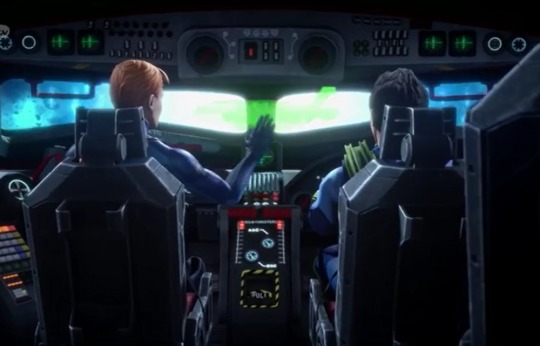
Daily Dose of Thunderbirds
I absolutely adore this moment where John pulls up the EMP and zaps the Zero XL (Eos will probably never let him forget it - hence why he wasn’t immediately in the cockpit in the scene afterwards - he was checking on Eos). ::wonders if it might be lying around somewhere as a gif that could be gazed at extensively :D ::
But this moment, Virgil and John together like we’ve never seen before (though I have to say that John obviously knows Two well...what don’t we get to see????) Both professional, smart and powerful. It is just great to see them together.
Also headcanon - the EMP was installed after the episode ‘Chaos’ where it was obviously a gap in their toolkit. Brains would have been very annoyed and patched that gap asap.
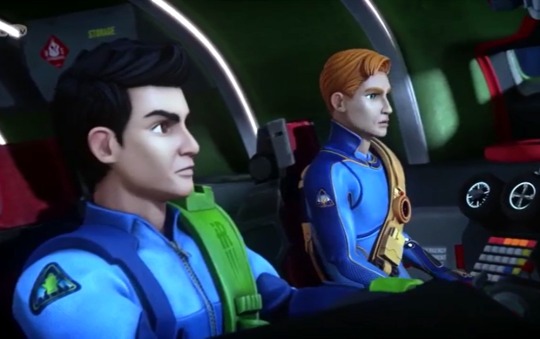
Aaaah, what am I doing? I’ve written this all in a fic. Have a excerpt of Thunderbird XL (it’s unfinished, but still has a few interesting bits in it).
-o-o-o-
Two was so familiar it hurt.
One was his daydream, but Two was his reassurance.
Virgil didn’t say anything as he helped him through the corridors. A mop of black hair was his only sight as he looked down at the big man under his arm.
The shoulders supporting him were far broader than he remembered. It slowly began to sink in exactly how much he didn’t know. The uniform was familiar. The green baldric and kit. The tools were new and Jeff frowned at them as if to accuse them of betraying his faith in his knowledge. Why Virgil felt he had to carry a screwdriver around with him everywhere, he had no doubt his son could tell him if he asked.
But he didn’t.
They arrived at the room he expected and it was with some relief that it was what he expected.
It wasn’t until Virgil velcroed him to the bed that he saw the dent in the ceiling. “How did that happen?” It was out before he could think twice.
Virgil looked up from the tray of supplies that were not designed for an antigravity environment and frowned at the bulkhead above them.
“Oh, the exo-suit.”
“What was the exo-suit doing in here?”
Virgil pulled out a palm scanner and began a methodical examination. “Got myself trapped in it. Tried to get myself out. Didn’t go well.”
Jeff stared at the side of his son’s head, but didn’t ask the obvious question as Virgil stared at the hologram of a very battered old body above the bed.
Virgil’s hitched breath was the only sound in the room.
“I-I need to give you some supplements. A painkiller would probably be a good idea.”
“No, son. I can last a little longer. Need a clear head.”
Brown eyes caught his for just a moment before looking away. “There isn’t much else I can do until we get you to a hospital.” Virgil turned away, once again fiddling with equipment, unwrapping a hypodermic needle and fussing with a small bottle of liquid. “This is a basic dose of necessary vitamins and minerals.”
Virgil’s eyes were on anything but his father and the hologram above him.
Jeff reached over to one of the many patches on his suit and unwrapped the seal on his arm. “You’ll need to secure it again.”
His son blinked but said nothing, administering the dose to his father and rebinding his suit with tape. “We need to get you a new uniform.”
“It is enough for the moment, Virgil. We need to get back up top and get out of here.”
He saw the hesitation flicker across that longed-for face. “You’re lying down on one of the medbeds in the cockpit. You’re going to let the medscan finish so when we reach home, we have enough data to know what we have to do.”
Jeff eyed him. The changes were subtle. The confidence level was much stronger, more assured, despite the situation.
“Virgil, we need you up here.”
John’s voice would forever be music to his ears.
“FAB.” A swallow, and Jeff could see his son visibly gather himself. “C’mon, Dad. We have a rescue to complete.”
Detaching him from the bed, Virgil again wrapped his arm around his father and helped him through the great green ship.
Both Gordon and John were in the cockpit. The medbed had already been deployed and was ready waiting.
It very quickly became clear that he had no say in whether he was going to lie on it or not.
Virgil’s directions stood for no argument and to be honest, Jeff didn’t really want to put up a fight, but there was so much to see! After so long alone with only rock and the same broken ship to stare at, everything was so rich in colour.
And his sons. His beloved sons.
He watched their every move, part of him still unable to believe that they were really there.
Virgil fussed, obviously fighting his own demons. Gordon chattered incessantly, but Jeff was so happy to hear and see him, he had no protest.
And John, his saviour…Jeff had never been one for the musical arts, that was always Lucy’s department, but to hear his boy’s voice free of static and interruption…
Reality threatened to fracture.
So, he obeyed his worrying sons and lay down on the medbed. Gravity, wasn’t a factor at the moment, but when they reached Earth it was going to be a definite problem.
Reached Earth?
He swallowed a lump in his throat as Virgil was finally urged to the pilot’s seat and the great ‘bird around them came to life.
He had to see this, so he sat up on the bed and watched.
John contacted the Zero XL. The name of the ship that had brought his boys here felt wrong, as if he had been aboard the Titanic and was now being saved by the Titanic II, but the moment the ship answered…
Brains.
The joy in the man’s stuttering voice had Jeff’s heart stuttering along with it. Not only had his boys come all this way, but Brains as well?
The Brains he knew wasn’t a physically active man. His specialities were academic. He had never been comfortable in space or even aboard the Thunderbirds he had designed, yet here he was, out here where literally only one man had gone before.
Jeff’s heart swelled almost to breaking.
John cut off the connection and that voice was gone. Only to be replaced by those of his sons as they coordinated the return trip.
Scott was clearly in command, but Virgil had his own responses and John was sharp and sure. Gordon sat back quietly, his stream of excited words apparently spent, but his posture was active, as if he was ready to move at a moment’s notice. He turned, looked at Jeff and smiled, his eyes glittering in the overhead lighting.
It became apparent very quickly that his boys’ skillsets had advanced considerably while he was gone.
Which really? Was to be expected, but time and memory were two different things.
The red of Thunderbird Three coasted effortlessly between spinning and colliding rocks, One and Two following best they could.
“Who taught Alan to fly like that?”
Gordon snorted. “He’s pretty much a natural.”
“Dad, you need to lie down flat and let the medscan finish.” Virgil threw it over his shoulder and Jeff got the impression that if the man didn’t have to fly his ‘bird, he would still be fussing.
“You sound like your Grandma.”
His mom.
Mom.
Virgil’s tone lightened and his voice was grinning. “Yeah. Who is always right.”
Hmmm. Perhaps some things hadn’t changed.
-o-o-o-
He did lie down eventually, if only to stop his second eldest from fretting. Gordon turned around at one point and whispered that if he didn’t do what Virgil said, things could get scary. Apparently, he was speaking from experience.
So, the medscan was completed and the nagging stopped.
But then they arrived at the Zero XL and Brains refused to respond. It appeared that his Titanic analogy may be far too possible.
Was fate really going to do this to him? Dangle rescue and then snatch it away?
And leave his boys stranded with him?
Then International Rescue responded.
Situation called, examined, orders issued, resolution found and executed.
A moment of panic to a moment of shocked stillness. The Zero XL floated silent in space, the emptiness eating it with its lack of light.
For all its nomenclature, the ship looked nothing like its predecessor.
Was that Thunderbird Five on its bow?
“Thunderbird Two, I need options. How do we get onboard?” His eldest’s son’s voice was a balm against the emptiness. “The docking ports are still closed.”
“I’m working on it, Thunderbird One.” John’s voice was ever so calm. The communications expert flicked a switch on the dash. “Eos, do you read?”
“I’m here, John. Though I would appreciate you never doing that again.”
His son sighed. “You were safe, Eos. We’ve gone over this before.”
The female voice was strident. “That is all very well for you to say, you weren’t the one being shot at.”
Jeff frowned. Who else was aboard the Zero XL? The voice was unfamiliar and sounded very young.
“We have a time limit, Eos. Do you still have access to the Zero XL’s systems?”
“Some. You did do damage with that little trick.”
“We need to dock, Eos.”
“Do you have the password?”
“Eos!”
“You did say I should work on my humour.”
Despite the playful tone, it appeared that Eos knew what she was doing as the Xero XL at least partially came to life, sections opening. He watched as Alan slid Three into a port at the rear. One settled into something similar, and then Two slipped under the ship’s belly and docked with a soft thud.
Virgil spoke briefly with Alan and his ‘bird was secured.
The moment Virgil was out of his pilot’s seat, he was beside Jeff, unstrapping him.
“Gordon, meet with Scott and secure the ship.”
“FAB.” The aquanaut’s eyes sparkled at Jeff again as Gordon briefly touched his shoulder before turning sharply and leaving through the rear door.
John was still sitting in his chair, speaking to the woman who continued to be both efficient and difficult.
“Who is she?” He said the words quietly, but Virgil heard him, his head coming up with a small smile.
“She’s Eos. John can fill you in.”
“Okay.” There was obviously a story there. “So, what’s with the EMP weaponry?” He arched an eyebrow.
Virgil’s smile vanished to be replaced with a frown and he looked down. “Brains designed it after the incident with the GDF’s rescue robots.” He cleared his throat. “A lot has happened.”
Quiet. “I’m sure it has.”
His son’s frown was targeted at the bed’s readout before Virgil reached over and lifted Jeff gently off the mattress and set him floating vertical again. “How does that feel?”
Jeff smiled just a little. “It does the job.”
Regardless, Virgil slipped his arm around his waist again and led him out of Thunderbird Two.
The difference between the interior of Two and the Zero XL was vast. He went from reassuringly familiar to alien in moments.
He missed the green immediately.
“Who built it?”
“Mostly Brains.”
“Mostly?”
Virgil didn’t answer and Alan joined them, again reaching out to hug Jeff, chattering just as happily, if not more than Gordon earlier. Virgil didn’t join in, but neither did he let go.
And then they were at the bridge of the ship. Virgil let him go and Brains was smiling up at him. It was so good to see him.
“It’s good to see you, Jeff.”
His own name forced his heart into his stomach. The man was an older version of his business partner, but his expression, his complete lack of stutter…it had been eight years, but Jeff Tracy had worked so many hours alongside this man, he knew him.
And it wasn’t him.
There was only one person it could be and for a split second, part of him wailed at the injustice that Gaat had followed his sons out here to corrupt these moments as he had corrupted everything else ever since he had met the man.
“It’s good to see you, too.” And he offered his hand.
As Gaat reached to shake, Jeff could see fear in his eyes. Perhaps that was what kept the bastard going all these years. A need to prove that he wasn’t afraid, that he wouldn’t run again when faced with the one man who had managed to prevent him from succeeding all those years ago.
The grip of his limp hand closed the deal.
Jeff spun the man around, wrenched his arm up his back and shoved him face first into the bulkhead.
-o-o-o-
Thunderbird X & Thunderbird XL
#thunderbirds are go#thunderbirds fanfiction#thunderbirds#John Tracy#Virgil Tracy#TBDailyDose#nuttyfic reblog
21 notes
·
View notes
Text
"Cortex Prime is, in my opinion, one of the most flexible and powerful rules toolkits on the market. It’s also a toolkit that takes some effort and consideration to set up, which has prevented it from taking off in the same way as the similar but much simpler Fate. Cortex Prime also has many fewer worked examples than Fate, which has the exemplary Fate Worlds series as well as a number of Fate System Toolkits; instead, Cortex only has Tales of Xadia as a fully implemented Cortex game outside of its three in-book examples which are too short and a bit too unconventional to be accessible demos (their genres are police procedural, rescue team, and neo-classical fantasy). A good system hack will walk through the various mechanics, mods, and character options and discuss why each choice is made and how they’re going to work in the final product.
I have not myself chosen a conventional genre or even game idea for this system hack. Instead, I’ve chosen one of my secret game design white whales and, to avoid blank page syndrome, decided to implement it in Cortex Prime instead of writing new mechanics. This game design white whale is (fairly obviously if you read the title of the article) a colony sim." - @levelonewonk
1 note
·
View note
Photo

Fate Accessibility Toolkit
The Fate Accessibility Toolkit is a new toolkit for Fate Core that brings characters with disabilities into your game and supports players with disabilities at your table. We’ve assembled a team from disabled communities to ensure that this book speaks to you from their real, lived experiences.
You’ll also want a copy of Fate Core or Fate Accelerated to play; that said, we provide plenty of advice and perspectives you can use with any game system!
Inside the Fate Accessibility Toolkit you'll find:
An exploration of the challenges and experiences facing people with a variety of physical and mental disabilities, in their own words.
Advice on compassionately and respectfully playing characters with disabilities, as well as strategies for welcoming disabled players to your game table.
Discussion of specific disabilities, including blindness, D/deafness and hardness of hearing, mobility issues, dwarfism, chronic illness, autism, depression, anxiety, schizophrenia, bipolarity, and PTSD.
Options for representing disability in the Fate system, using a mix of aspects, stunts, and conditions, and including an exploration of adaptive devices available to characters across a variety of settings.
Appendices focused on creating safe spaces at your table, an ASL reference for common RPG terms, and a large-print character sheet for Fate Core.
This is the Prototype Edition of the Fate Accessibility Toolkit. What's that mean?
TL;DR: There's no art, but sales of this will help us get art, and once we get art, we'll upgrade your PDF to one with art at no added cost.
The Fate Accessibility Toolkit has been under development for several years at Evil Hat. During that time we’ve gone through a number of transitions. Towards the end of 2018, Evil Hat realized it was over-extended and needed to slim back its product offerings for the coming year. You can read more about this in our public blog post from then, found here: https://www.evilhat.com/home/refocused-resized-hat-mode-activated/
Even facing some financial turbulence, we remained committed to Fate Accessibility. The mission of the book was too important to us to consider canceling it. We knew we would be able to ensure that the game’s text would be completed at the very least, and we knew we could make that text available to the public if all other avenues failed.
So for the Fate Accessibility Toolkit, we’re going to do a “Prototype Edition” release. While there isn’t budget to make the art happen at this time (let alone put the book into print), we can make the content of the book available to you now. So with that in mind, we’ll sell Fate Accessibility in this art-free form (the grey rectangles throughout the text are place-holders for eventual artwork) until it generates enough revenue to pay for the missing art budget (likely requiring several hundred sales as a baseline).
Once we have that, we can commission the art, and at least provide a final version of the book in electronic form. (If that happy event comes to pass, we’ll upgrade all purchases of the Prototype Edition PDF to the full final PDF version at no added cost.)
As to whether or not the book will see print, who knows? At the least, if we get the budget for art, we’ll be able to take a look at making it available as a print-on-demand title here on DriveThruRPG. If interest is high, we may go beyond that. Your purchase is your vote! (And thank you for your support.)
24 notes
·
View notes
Link
I just bought this within the last ten minutes.
I am on Page 8.
I already love this book.
It was worth the money just for the words in the introduction section.
If you are into RPGs, or you write, maybe consider picking up this book.
3 notes
·
View notes
Text
(Sorry to hijack your post OP. It has a point, I promise.)
This is great! As a disabled gamer, I'm always happy to see accessibility in gaming! It's a passion of mine both in ttrpgs and video games.
Something to note is that DnD is a very rules-heavy game and that isn't great for everybody. I know that right now, DnD is the default for ttrpgs, but there are other systems out there with simple rules or different themes and they may be worth looking into!
Powered by the Apocalypse is a very simple system with a lot of games made with it. (Dungeon World, Root, Monster of the Week, Avatar Legends, Thirsty Sword Lesbians, and Monster Hearts, are some popular ones.) It's a d6 based system where you roll 2d6 as a resolution mechanic. A result of 10+ means the character gets what they want, 7-9 is a partial success (meaning success with a twist), and 6 or less means the GM gets to make things more interesting.
Admittedly PBtA isn't my favourite system. I don't really like partial success, personally, because I find it overwhelming. The system purposefully lacks structure, which can be hard for ND people like myself, but it leaves a lot of room for creativity. Those are my personal complaints so take them with a grain of salt. It is a very well-loved system!
I've heard really good things about the Cypher System too. It's the system that the new Old Gods of Appalachia game, but I haven't played it myself.
Fate is also great. It's flexible and can be used to run a lot of different types of games. Fate Condensed is a compact, stand-alone version of the Fate Core System, streamlined for clarity and ease of reference. The creators also have The Fate Accessibility Toolkit, which offers a wealth of advice and guidance for Fate Core that brings disabled characters into your game and supports disabled players at your table. I love that they have an accessibility-specific add-on.
There are tons more and I'm always glad to talk about other systems if people would like! They tend to move into different genres and playstyles. (Vaesen by Free League is my favourite game-- it's gothic horror with nordic folklore and super easy, but it's horror so it contains some triggering content. Wanderhome is a pastoral fantasy with zero combat and feels like a Studio Ghibli film.)
As for OP's creation (link to their Etsy page), it looks super good! I'm glad they've made something that makes the game easier for ND people who have their hearts set on DnD!
As for physical disabilities, I like the writing on it-- it's easy to see and read for visually impaired people like myself, but I'm not sure if it's good for dyslexia. It doesn't rely on colours for ease of use, so it should be good for colourblind people too! I can't speak to whether their PDF to print at home is screen reader accessible since I don't know much about them, but it doesn't look like it (OP please correct me if I'm wrong and I'll update this to reflect it!). I do wish there was an option to print it off in a standard vertical 8x11 page so that it could be put into a binder or something instead since I find that would take up less space on the table. Having it shaped like a DM screen also makes it difficult to play with minis on the table.
Need a little help with the D&D rules?
Neurodivergent? - me too!
I made this to make the game more accessible to everyone.
Get one today on Etsy - Link in bio/comments
#ttrpg #dnd #neurodivergent #dnd5e
1K notes
·
View notes
Text
Total War Warhammer 3 DLC Modes Land for Free Alongside Chaos Dwarfs
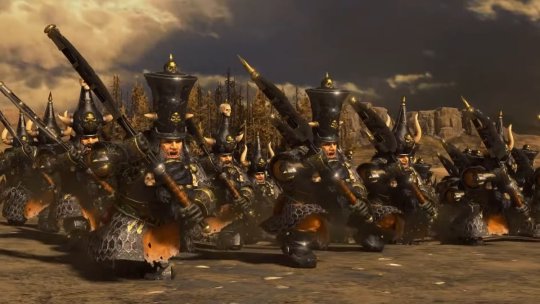
When Total War Warhammer 3 update 3.0 launches on April 13, fresh, free Content will be available. Two brand-new game types are added in the fantasy strategy game's Mirror of Madness Expansion, which is free for all Total War Warhammer 3 players. The two game modes consist of a challenging survival challenge format and a "reality-bending" mode that lets players drastically change how TTW3 behaves. When it releases alongside Total War Warhammer 3 update 3.0, you’ll be able to find the Mirror of Madness mode on the Battle tab from the game’s main menu. There, you’ll have access to two modes – Trials of Fate and The Infinite Portal. The former is a struggle for survival through infamous battles from Warhammer history, while the latter puts control directly in your hands with a wealth of gameplay-altering settings to tweak. The pair of modes arrives alongside the incoming Total War Warhammer 3 Chaos Dwarfs DLC on April 13, but you won’t need to purchase the Chaos Dwarfs to play the two Mirror of Madness modes. They will be freely available to all players of Total War Warhammer 3 when update 3.0 releases. Total War Warhammer 3 Trials of Fate mode The Trials of Fate are “a series of intense survival challenges where players assume the role of a newly ascended Daemon Prince of Tzeentch.” You’ll have to fight against endless waves of enemies that grow ever stronger, defending an object called the Shard across four battles from the past, before taking the fight to Kairos Fateweaver in a climactic showdown. It’s not all bad news, however – you’ll have “unique spells and abilities” at your disposal to help survive this ultra-challenging mode. You’ll be able to upgrade these using Forbidden Knowledge, which is accumulated as you defend the Shard from attack. Dealing more damage and bringing down as many enemy units as possible will boost your score, unlocking new Daemon Prince parts that can also be used across both the Realm of Chaos and Immortal Empires campaigns, the latter of which is now available to all TWW3 players. Total War Warhammer 3 The Infinite Portal mode The Infinite Portal is a “reality-bending” mode that grants you the ability to manually alter the very fundamentals of how Total War Warhammer 3 plays. That’s a pretty dramatic toolkit, letting you change everything from the number of soldiers per unit and the damage dealt by individual attacks and spells to the strength of gravity and even the size of single-unit entities such as Lords and Monsters. Here are all the modifiers you can change with The Infinite Portal: - Unit Size: Increases the number of soldiers per unit and their health. - Damage: Increases the damage dealt by attacks, spells, etc. - Impact Force: Increases collision impact, attack force and detonation force to send units flying. - Leadership: Increases base morale. - Winds of Magic: Increases the availability of Winds of Magic for spellcasting. - Explosions: Increases the size of explosions and vortex spells, improving their radius and detonation speed. - Vigour Cost Reduction: Increases the duration that units stay fresh, lowering the fatigue cost of actions. - Reload Time: Reduces the time it takes to reload ranged weapons. - Ammunition: Increases the total number of shots per ranged unit. - Projectile Penetration: Increases the distance projectiles can travel through enemies. - Gravity: Decreases the effect of gravity on units who are knocked into the air. - Ability Radius: Increase the effect radius of abilities. - Ability Recharge: Reduces ability recharge time. - Charge Duration: Increases the duration of the charge bonus. - Entity Scale: Increases or decreases the size of single unit entities like Lords and Monsters. - Blood Quantity: Increases or decreases the amount of blood emitted by entities emit. Creative Assembly says that “Mirror of Madness in and of itself makes no difference to Warhammer 3’s performance.” However, it does note that “should you crank up the Infinite Portals more intensive settings (such as entity scale or unit size) you may begin to notice some performance drop-off, depending on the power of your PC.” https://www.youtube.com/watch?v=LSx_gOmoEI0 It encourages players to see The Infinite Portal as “an experiment, with the chance… should you so choose… to push your PC’s hardware to the limit.” It adds that while Trials of Fate should also maintain similar performance to the main game, “players who survive for a long time may find that the sheer number of units on screen at once in later waves may stretch their system resources.” Make sure to browse our guide to all Total War Warhammer 3 races to make sure you’re ready to take on these new modes on April 13. If The Infinite Portal isn’t enough customisation for you, we’ve picked out the best Total War Warhammer 3 mods to take things even further, along with highlighting the best Warhammer games on PC in 2023. Read the full article
0 notes
Text
Popular Carbon Neutral Fuel News
Maersk secures green e-methanol for the world’s first container vessel operating on carbon neutral fuel
European Business shippers reception and abroad face increasingly unfair competition from China’s state-owned shipper, COSCO. But there are several measures the EU could use to counter this, argues Jacob Gunter. When COSCO, China’s gigantic state-owned shipper, attempted to need shares within the Port of Hamburg recently it reignited the mention imbalances in access to European and Chinese shipping markets. it's considerably easier for China’s shippers to access European markets than the other way around. This presents a long-term risk to European competitiveness within the industry. Europe has options at its disposal to remedy this, and thus the earlier it does so, the upper. The imbalance, explained Nearly every country has cabotage laws – rules that restrict foreign-flagged vessels from engaging in domestic shipping. European countries aren't any different. EU cabotage laws demand that only locally-flagged vessels can participate. This includes inland bodies of water, but also shipping between ports within an equivalent country. China’s cabotage laws go one step further. Domestic shipping can only be performed by Chinese-flagged vessels that are also owned by a Chinese company. What the laws means in practice is that, as an example , a Chinese-flagged vessel cannot ship goods between Dutch cities on the lower Rhine, whilst a Dutch-flagged vessel cannot ship goods along the Yangtze. The Chinese-flagged vessel would even be barred from onloading goods in Amsterdam and offloading them in Rotterdam across the North Sea , whilst the Dutch-flagged vessel couldn't take goods from Qingdao to Fuzhou along the East China Sea. However, whereas COSCO could invest during a subsidiary within Netherlands and run Dutch-flagged vessels between inland and coastal ports alike, a Dutch shipper couldn't invest during a subsidiary in China to run Chinese-flagged vessels. The issue extends to a practice mentioned as international relay – the reorganizing of products collected from multiple ports within an equivalent country for shipment abroad. Chinese-flagged vessels can do this between ports during one EU-member state, also as between different countries. Three Chinese-flagged vessels owned by COSCO could load on beer in Hamburg, cheese in Rotterdam and chocolate in Antwerp, then all meet at one port and redistribute their cargo so as that one could attend Canada, another to South Africa and thus the last to Singapore. This enhances global shipping efficiency and explains why China is keen to require an edge in European ports like Hamburg – an honest place to transship for northern Europe – and Piraeus – a superb transshipment site for southern Europe that's also just across the ocean from the Suez Canal . Unfortunately, the same rules in China governing domestic shipping hold true for international relay – it isn't enough to be Chinese-flagged, an organization must even be indigenous to the market. So, three Dutch-flagged vessels owned by a Dutch shipper couldn't onload fruit from Qingdao, rice wine from Ningbo and tea from Quanzhou, then all shuffle cargo during a port in China . Instead, they could need to attend a close-by country like South Korea or Japan to redistribute goods to send off to varied destinations. European shippers are clearly at an obstacle to Chinese ones. this is often often especially pronounced because of the number of products that are exported out of China , which boasts nine of the world’s twenty busiest ports across an enormous coastline. as compared , the Chinese vessels going between Hamburg, Rotterdam and Antwerp all have a visit shorter than the one between Tianjin and Qingdao. The implications of inaction This imbalance is troublesome for European shippers both now and within the long-term. Europe currently boasts four of the five largest shipping companies within the planet as measured by freight (COSCO is that the third largest). For now, European shippers have scale on their side. However, with a protected domestic market, COSCO and other Chinese shipping companies are build up massive scale which can then be exerted into other markets. Yet, the challenges presented by COSCO transcend just this imbalance. COSCO is directly controlled by SASAC (State-owned Assets Supervision and Administration Commission of the State Council), which governs China’s biggest State-owned enterprises (SOEs), including most of the upstream value chain that feeds into COSCO. because the ecu Union Chamber of Commerce in China put it within the ir 2020 report on European involvement within the Belt and Road Initiative: “Chinese shippers use ports built and pass by SOEs using steel and cement provided by SOEs; they use vessels built by [China’s state-owned ship-building monopoly] using steel made by SOEs, which is produced using iron and coal from SOEs; all of which is financed by SOE banks.” China’s SOEs benefit not only from subsidies, they also enjoy privileged access to factors of production like free land and dirt-cheap capital. This support can become hidden within the upstream value chain that feeds into the highest user – COSCO. Additionally, anywhere along this value chain, cheaper prices and favorable deals at one or more stages can ultimately benefit shippers. When combined with the unbalanced playing field and thus the protected domestic market, the long-term implications for European shippers could be bleak. A blueprint for reciprocity, positive or otherwise While Europe discusses the fate of the Port of Hamburg, it should also consider the broader situation. If sufficient political will are often mustered, a few of straightforward measures could be introduced within the EU. A common market cabotage law could be developed that allows member states to require care of their current rules domestically while also preventing Chinese shipping companies from exploiting the close proximity of European ports that lie across national borders. A reciprocity review mechanism that's almost just like the proposed International Procurement Instrument could be legislated. this is often ready to allow the EU to measure the extent of openness of foreign markets to European shippers, then impose reciprocal restrictions on companies and vessels from that market. Ideally, these measures would yield swift negotiations with Beijing that leave its shipping markets as open as those of the EU. If Beijing refuses to budge, then this toolkit would a minimum of protect Europe’s shipping market from China’s distortions. It would not necessarily be easy to make consensus between all member states, but if achieved, it'd be an honest test for the EU to make out a toolkit that advances reciprocity. Compared to other efforts at showing Beijing that Brussels shipping can play hardball, this is often ready to be low-hanging fruit, and can do considerably sort of a confidence-building exercise within the broader competition with China within the economic arena.
0 notes
Link
An instantly recognizable member of Toho's kaiju lineup and a fan favorite overall, Mothra is an aptly-named giant moth that kaiju fans the world over know and love. Across many Godzilla films as well as some solo appearances, Mothra is one of the few kaiju that is always presented as unambiguously good and friendly to mankind. Mothra is a selfless protector of the Earth and a frequent ally of humanity. Her stories typically touch on themes of environmentalism, as well as death and rebirth, making her a welcome addition to any piece of kaiju media.
RELATED: Godzilla: The 10 Most Iconic Kaiju, Ranked
Not every Mothra movie is created equal, however, and, across the many films in which she has appeared, there emerges a fairly clear hierarchy of the best movies that star or guest star everyone's favorite giant flying insect.
10 Rebirth Of Mothra II (1997)

Arguably the weakest of the Rebirth of Mothra trilogy, a series of solo films marketed with younger audiences in mind, Rebirth of Mothra II succumbs to a number of pitfalls that make it a lackluster kaiju movie overall. Most of the film's human elements are taken up by children running around a sunken temple with somewhat unclear goals, which doesn't do any favors to the pacing.
Although kaiju action has a little too much downtime, there are some downright outrageous abilities Mothra gets access to in this one to keep it interesting. This might not be a great movie overall, but seeing Mothra morph into dozens of tiny Mothras to attack her opponent from within makes some of it worthwhile.
9 Rebirth Of Mothra III (1998)

The final entry in the Rebirth of Mothra trilogy is of middling quality overall; although it leans more heavily into kaiju action and has overall better effects than its predecessor, it still falls short of the original Rebirth movie on account of its less-than-stellar human characters.
King Ghidorah wants to kidnap the children of Japan for some reason, and Mothra has to go back in time to defeat a younger Ghidorah like some kind of kaiju terminator. These plot points are interesting enough in themselves and they set up some great action sequences, but the movie is a bit muddled overall. Generally speaking, the second and third movies in the Rebirth trilogy ought to be reserved for only the most ardent Mothra fans because it's hard to forgive their shortcomings otherwise.
8 Godzilla: Tokyo S.O.S. (2003)

Largely remembered for being the not-as-good sequel to 2002's Godzilla Against Mechagodzilla, Tokyo S.O.S. is a movie that features Mothra and her fairies attempting to convince the human characters of the film to stop messing around with Mechagodzilla, lest they suffer a terrible fate. Things aren't so simple, though, as Mechagodzilla represents humanity's last line of defense against a renewed Godzilla menace.
RELATED: Mechagodzilla: Every Power The Daikaiju Has
Unfortunately, the movie takes a little bit too long to get going, choosing to reserve the appearance of its monsters for too late in the game. Although things do pick up once the kaiju hit the scene, it's still hard not to feel like it can't quite stack up to its contemporaries, and Mothra's inclusion touches on themes that have been handled better elsewhere.
7 Godzilla: King Of The Monsters (2019)
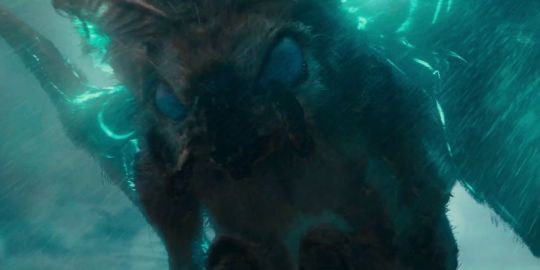
The second Godzilla entry in Legendary's "Monsterverse" is a big-budget kaiju crossover featuring Godzilla himself alongside his legendary rivals King Ghidorah, Rodan, and, of course, Mothra. This film makes a lot of notable changes to Mothra's toolkit; she's notably without her twin fairy escorts and this time opts for two-bladed front legs over lasers.
Reviews of King of the Monsters at the time were sharply critical of the human-centered drama, but they generally praised the realization of several classic Toho monsters, Mothra included. Indeed, the big moth certainly does look great in this movie, and she gets some impressive fight scenes, making this one worth a watch.
6 Ghidorah, The Three-Headed Monster (1964)

In one of the wackier plots to meet the history of kaiju cinema, this is a movie involving an assassination plot of a political figure, an invading astro-monster, possession by Mothra's fairies, and a spirited kaiju round-table debate with the fate of the human race in the balance. Indeed, with King Ghidorah is set to destroy Earth, Godzilla and Rodan have the power to stop him, but only if Mothra can convince them to work together first.
RELATED: The 15 Best Godzilla Enemies, Ranked
This is one of those movies that really thrusts Mothra into the kaiju peacemaker role that she so often inhabits, and to great effect. Watching her literally mediate an angry argument between Godzilla and Rodan while the fairies translate for the audience is not to be missed, and is certainly a scene that belongs in the hall of fame for kaiju history.
5 Godzilla vs. Mothra (1992)

Godzilla vs. Mothra is a confusingly titled remake of sorts of 1964's Mothra vs. Godzilla, and, as such, the movie follows similar plot beats to the original. Greedy businessmen with no respect for the environment pick up a giant egg, Godzilla is upset, Mothra hatches from said egg, etc., etc.
However, there are a couple of twists this movie introduces to keep it feeling fresh for those who have already seen Godzilla and Mothra's inaugural showdown from 1964. There's some fun family drama stuff, featuring an Indiana Jones wannabe trying to reconnect with his daughter while navigating his divorce settlement, and also a "Dark Mothra" that must be defeated. The effects and miniatures in the final battle are impressive as well, making this a diverting kaiju romp.
4 Rebirth Of Mothra (1996)
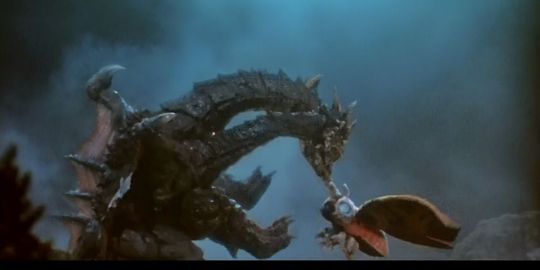
Without a doubt the best of the Rebirth of Mothra trilogy, this film sees a new-and-improved Mothra—read, more lasers—going head to head against Death Ghidorah. The kaiju action here is extremely impressive, with the suits having remarkable ranges of articulation and great built-in pyrotechnics to explode all over the place when one of them gets hit by a beam.
Although the movie starts slowly and leans a bit too heavily into the child-friendly tone of the trilogy, the character drama here is quite effective in its own right, and it's a welcome complement to the battle sequences that populate the second half of the movie.
3 Mothra vs. Godzilla (1964)

Mothra vs. Godzilla is remembered as a kaiju classic from the earlier Toho films of the 60s and 70s, and it certainly is a lot of fun. The plot should be somewhat familiar by this point; a greedy businessman finds a giant egg and plans to use it as a tourist attraction, but this upsets Godzilla, who in turn leads to Mothra hatching from the egg, and a decisive battle.
RELATED: Godzilla VS. Kong: Ranking The Human Characters By Intelligence
Despite Godzilla being in the title, this is still mostly Mothra's movie, although Godzilla does make one of his most iconic entrances in this one, and the human characters happily have quite a bit to do in order to keep the plot moving at a brisk pace. The only thing keeping this film from being truly great is a somewhat lackluster final battle, but it's still a great time overall.
2 Mothra (1961)

Mothra's big-screen debut is still one of her most successful appearances, and it establishes many of the tropes that would be associated with the character going forward. Mothra's fairies are kidnapped from Infant Island to be exploited as tourist attractions, which angers Mothra and invites her destructive wrath.
The cast here is great, as well; there's an outrageously villainous businessman as an antagonist as well as an assortment of likable but dubiously competent protagonists who set out on a quest to return the fairies to Mothra before it's too late.
1 Godzilla, Mothra, And King Ghidora: Giant Monsters All-Out Attack (2001)

As a longtime fan favorite, GMK is a movie that gleefully upends the typical character roles that kaiju fans had become familiar with across decades of Godzilla material. Godzilla is a villain of pure malice this time around and a serious threat to the continued survival of Japan, and possibly the world! As such, it's up to two familiar monsters to stop him: Mothra and... King Ghidorah?
Featuring eye-popping special effects, outstanding kaiju battles, and a great cast of human characters, GMK is a movie that easily lands itself in the upper echelons of the kaiju film tier list. It's also exciting to see Mothra and Ghidorah team up, as that's not a pairing fans are familiar with.
NEXT: 10 Best Kaiju Movies Like Godzilla vs. Kong
The 10 Best Kaiju Movies Featuring Mothra | ScreenRant from https://ift.tt/3tMF1mj
0 notes